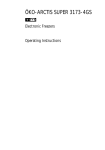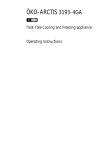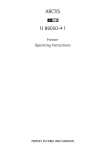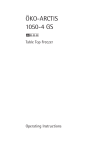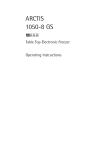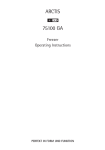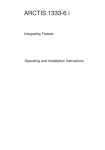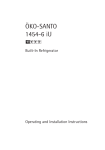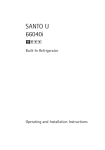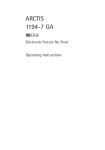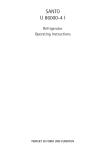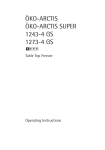Download Electrolux 1254-6 iU User's Manual
Transcript
ÖKO-ARCTIS 1254-6 iU Built-in freezer Operating and Installation Instructions Dear customer, Before placing your new refrigerator/freezer into operation please read these operating instructions carefully. They contain important information for safe use, for installation and for care of the appliance. Please keep these operating instructions for future reference. Pass them on to possible new owners of the appliance. These operating instructions are for use with several technically comparable models with varying accessories. Please observe the notes which apply to your model. ☞ Notes which are important for your safety or for the proper functioning of the appliance are stressed with a warning triangle and/ or with signal words (Warning!, Caution!, Important!). Please observe the following carefully. This symbol guides you step by step in the operation of the appliance. Supplementary information regarding operation and practical applications of the appliance appear after this symbol. Tips and notes concerning economical and environmentally sound use of the appliance are marked with the cloverleaf. The operating instructions contain instructions for the correction of possible malfunctions by the user in the section "What to do if ...". If these instructions should not be sufficient, our customer service department is always available to you. Printed on paper manufactured with environmentally sound proceses he who thinks ecologically acts accordingly... 2 Contents Important Safety Instructions . . . . . . . . . . . . . . . . . . . . . . . . . . . . . . . . . . 4 Disposal. . . . . . . . . . . . . . . . . . . . . . . . . . . . . . . . . . . . . . . . . . . . . . . . . . . 6 Appliance Packaging Information . . . . . . . . . . . . . . . . . . . . . . . . . . . . . . . . . . 6 Disposal of old Appliances . . . . . . . . . . . . . . . . . . . . . . . . . . . . . . . . . . . . . . . . 6 Remove transport packaging. . . . . . . . . . . . . . . . . . . . . . . . . . . . . . . . . . . 6 Installation . . . . . . . . . . . . . . . . . . . . . . . . . . . . . . . . . . . . . . . . . . . . . . . . 7 Installation Location . . . . . . . . . . . . . . . . . . . . . . . . . . . . . . . . . . . . . . . . . . . . . 7 Reversing the door . . . . . . . . . . . . . . . . . . . . . . . . . . . . . . . . . . . . . . . . . . . . . . 8 Building the appliance in under a worktop . . . . . . . . . . . . . . . . . . . . . . . . . . 10 Fitting the plinth . . . . . . . . . . . . . . . . . . . . . . . . . . . . . . . . . . . . . . . . . . . . . . 13 Power supply. . . . . . . . . . . . . . . . . . . . . . . . . . . . . . . . . . . . . . . . . . . . . . . . . . 13 Electrical Connection . . . . . . . . . . . . . . . . . . . . . . . . . . . . . . . . . . . . . . . . . . . 14 Description of the appliance . . . . . . . . . . . . . . . . . . . . . . . . . . . . . . . . . . 15 View of the appliance. . . . . . . . . . . . . . . . . . . . . . . . . . . . . . . . . . . . . . . . . . . 15 Prior to Initial Start–Up . . . . . . . . . . . . . . . . . . . . . . . . . . . . . . . . . . . . . 15 Operating and indicator panel . . . . . . . . . . . . . . . . . . . . . . . . . . . . . . . . 16 Warning system . . . . . . . . . . . . . . . . . . . . . . . . . . . . . . . . . . . . . . . . . . . . . . . 17 Starting up and temperature regulation . . . . . . . . . . . . . . . . . . . . . . 18 Ice pack. . . . . . . . . . . . . . . . . . . . . . . . . . . . . . . . . . . . . . . . . . . . . . . . . . 18 Freezing and storing frozen food. . . . . . . . . . . . . . . . . . . . . . . . . . . . 18 Storage Goods Symbol/Freezing Calendar . . . . . . . . . . . . . . . . . . . . . 20 Preparation of Ice Cubes. . . . . . . . . . . . . . . . . . . . . . . . . . . . . . . . . . 20 Defrosting . . . . . . . . . . . . . . . . . . . . . . . . . . . . . . . . . . . . . . . . . . . . . . . . . . . 21 Switching off the appliance . . . . . . . . . . . . . . . . . . . . . . . . . . . . . . . . . . 22 Cleaning and care . . . . . . . . . . . . . . . . . . . . . . . . . . . . . . . . . . . . . . . . . . 22 Magnetic door seal. . . . . . . . . . . . . . . . . . . . . . . . . . . . . . . . . . . . . . 23 Energy Saving Tips . . . . . . . . . . . . . . . . . . . . . . . . . . . . . . . . . . . . . . . . . 24 What to do if .... . . . . . . . . . . . . . . . . . . . . . . . . . . . . . . . . . . . . . . . . . . . 24 Correcting Malfunctions. . . . . . . . . . . . . . . . . . . . . . . . . . . . . . . . . . . . . . . . . 24 Service & Spare Parts . . . . . . . . . . . . . . . . . . . . . . . . . . . . . . . . . . . . . . . 27 Help us to Help You . . . . . . . . . . . . . . . . . . . . . . . . . . . . . . . . . . . . . . . . 27 Customer Care. . . . . . . . . . . . . . . . . . . . . . . . . . . . . . . . . . . . . . . . . . . . . 27 Noises during operation . . . . . . . . . . . . . . . . . . . . . . . . . . . . . . . . . . . . . 28 Regulations, Standards, Guidelines . . . . . . . . . . . . . . . . . . . . . . . . . . . . . 28 3 Important Safety Instructions These warnings are provided in the interests of your safety. Ensure you fully understand them before installing or using the appliance. Your safety is of paramount importance. If you are unsure about the meaning of these warnings contact the Customer Care Department for assistance. Intended use • The freezer is intended for use in the home. It is suitable for the freezing of fresh food and storing frozen food, as well as for making ice. If the appliance is used for purposes other than those intended or used incorrectly, no liability can be accepted by the manufacturer for any damage that may be caused. • Alterations or changes to the freezer are not permitted for reasons of safety. • If you use the freezer in a commercial application or for purposes other than the freezing or frozen storage of foods, the manufacturer accepts no liability for any damages which may occur. Prior to initial start–up • Check the appliance for transport damage. Under no circumstance should a damaged appliance be plugged in. In the event of damage, please contact your supplier. Refrigerant The refrigerant isobutane (R600a) is contained within the refrigerant circuit of the appliance, a natural gas with a high level of environmental compatibility, which is nevertheless flammable. • During transportation and installation of the appliance, be certain that none of the components of the refrigerant circuit become damaged. • If the refrigerant circuit should become damaged: – avoid open flames and sources of ignition; – thoroughly ventilate the room in which the appliance is situated. Safety of children • Packaging (e.g. wraps, polystyrene) can be dangerous for children. There is a risk of suffocation! Keep packaging material away from children! • Please make old appliances unusable prior to disposal. Pull out the mains plug, cut off the mains cable, break or remove spring or bolt catches, if fitted. By doing this you ensure that children cannot lock 4 themselves in the appliance when playing (there is risk of suffocation!) or get themselves into other dangerous situations. • Often children cannot recognise the hazards present in household appliances. It is therefore important that you ensure adequate supervision and never let children play with the appliance! Daily Operation • Containers with flammable gases or liquids can leak at low temperatures. There is a risk of an explosion! Do not store any containers with flammable materials such as spray cans, fire extinguisher refill cartridges etc in the refrigerator/freezer. • Bottles and cans must not be placed in the freezer. They can burst when the contents freeze, high carbonate content drinks can even explode! Never store lemonade, juices, beer, wine, sparkling wine etc. in the freezer. Exception: high alcohol content spirits can be stored in the freezer. • Do not put ice creams or ice cubes in the mouth immediately after removal from the freezer. Very cold ice can freeze to the lips or tongue and cause injury. • Do not touch frozen food with wet hands. Your hands could stick to the food causing skin abrasions. • Do not operate any electrical appliances in the refrigerator/freezer (e.g. electric ice cream makers, mixers etc.). • Before cleaning the appliance, always switch off the appliance and unplug it, or pull the house fuse or switch off the circuit breaker. • When unplugging always pull the plug from the mains socket, do not pull on the cable. In case of malfunction • If a malfunction occurs on the appliance, please look first in the "What to do if ..." section of these instructions. If the information given there does not help, please do not perform any further repairs yourself. • This product should be serviced by an authorised engineer and only genuine spare parts should be used. • Under no circumstances should you attempt to repair the appliance yourself. Repairs carried out by inexperienced persons may cause injury or serious malfunctioning. Contact your local AEG Service Force Centre. 5 Disposal Appliance Packaging Information All materials are environmentally friendly! They can be dumped or burned at an incinerating plant without danger. About the materials: The plastics can be recycled and are identified as follows: >PE< for polyethylene, e.g. the outer covering and the bags in the interior. >PS< for polystyrene foam, e.g. the pads, which are all free of chlorofluorocarbon. The carton parts are made from recycled paper and should be disposed of at a waste-paper recycling collection location. Disposal of old Appliances For environmental reasons, refrigeration appliances must be disposed of properly. This applies to your old appliance, and - at the end of its service life - for your new appliance as well. Warning! Before disposing of old appliances make them inoperable. Remove plug from mains, sever the power cable, remove or destroy any snap or latch closures. This eliminates the danger that playing children lock themselves into the appliance (danger of suffocation!) or place themselves into other life-endangering situations. Disposal: • The appliance may not be disposed of with domestic waste or bulky refuse. • The refrigerant circuit, especially the heat exchanger at the back of the appliance, must not be damaged. • Information concerning collection schedules or locations can be obtained from your local Council or Environmental Health Office. Remove transport packaging ☞ 6 The appliance and the interior fittings are protected for transport. Pull off the adhesive tape on the left and right side of the door. You can remove any remnants of adhesive using white spirit. ☞ Remove all adhesive tape and packing pieces from the interior of the appliance. Installation Installation Location The appliance should be set up in a well ventilated, dry room. Energy use is affected by the ambient temperature. The appliance should therefore – not be exposed to direct sunlight; – not be installed next to radiators, cookers or other sources of heat; – only be installed at a location whose ambient temperature corresponds to the climate classification, for which the appliance is designed. The climate classification can be found on the rating plate, which is located at the left on the inside of the appliance. The following table shows which ambient temperature is correct for each climate classification: Climate classification for an ambient temperature of SN +10 to +32 °C N +16 to +32 °C ST +18 to +38 °C T +18 to +43 °C If the refrigeration appliance is installed next to another refrigerator or freezer a clearance of 5 cm at the sides is required, in order to prevent the formation of condensation on the outside of the appliance. 7 Reversing the door The side at which the door opens can be changed from the right side (as supplied) to the left side, if the installation site requires. Warning! When changing the side at which the door opens, remove plug from the mains. ☞ ☞ Left door opening: Remove the grid from the appliance by pulling it towards you. Remove the left side (A) of the grid cutting it from the rear (see figure). A ☞ Re-install the grid to the base of the appliance by pushing the clasps (a) until they click. a a 8 To reverse the opening direction of the door, proceed as shown in the figures: 9 Building the appliance in under a worktop ☞ The dimensions of the recessed installation area must correspond with those indicated in the figure. 60 0 5 min50 . 600 ☞ Remove covering and adjust the bracket locking nuts. ☞ Push the appliance into place. The plug socket necessary for connection of the appliance to the electricity supply should be positioned, so that the plug is not placed in the recess. ☞ 10 Adjust height. ☞ Mounting furniture door 11 ☞ ☞ 12 Screw appliance into place. Place the covering strip. Fitting the plinth a = 100 b = 150 A = 820 B = 870 Important! For the efficient operation of the appliance, it is important that the original ventilation grid is used. • For an opening height dimension A=820 mm and a plinth height dimension a=100 mm, the plinth may be fitted without adjustments. The same applies to an opening height dimension B=870 mm and a plinth height dimension b=150 mm. • For plinth heights greater than 580 a=100 mm, b=150 mm, a cut should 25 ÷8 be made in the plinth, 580 mm wide, 0 25 in the centre of the appliance position, leaving a remaining height 008 of a=100 mm, b=150 mm. • Attach plinth to the kitchen units. Important! The plinth must be positioned at a minimun distance of 25 mm from the door. Please check whether, after installing your appliance and especially after reversing the door, the door seal seals right round. A badly fitting door seal may lead to heavy frosting and result in a higher power consumption (see also “What to do if ...”). Power supply ☞ A correctly installed, earthed socket is required for the electrical supply. The supply must have a fuse rating of at least 10 Amps. If the socket is not accessible once the appliance is built in, the electrical installation must include suitable means of isolating the appliance from the mains (e.g. a fused spur). Before initial start-up, refer to the appliance rating plate to ascertain if supply voltage and current values correspond with those of the mains at the installation location. e.g.: AC 220 ... 240 V 50 Hz or 220 ... 240 V ~50 Hz (i.e. 220 to 240 volts alternating current, 50 Hertz) The rating plate is inside the appliance on the left. 13 The mains cable may only be changed by a qualified electrician or competent person. If your appliance needs repairing, please contact your local AEG Service Force Centre. Electrical Connection Any electrical work required to install this appliance should be carried out by a qualified electrician or competent person. WARNING – THIS APPLIANCE MUST BE EARTHED The manufacturer declines any liability should these safety measures not be observed. 13 AMP Before switching on, make sure the electricity supply voltage is the same as that indicated on the appliance rating plate. The rating plate is inside, on the left. The appliance is supplied with a 13 amp plug fitted. In the event of having to change the fuse in the plug supplied, a 13 amp ASTA approved (BS 1362) fuse must be used. Important GREEN & YELLOW 13 AMP. FUSE The wires in the mains lead are coloured in accordance with the following code: Green and Yellow Earth Blue Neutral Brown Live BROWN As the colours of the wires in the mains lead BLUE CORD CLAMP of this appliance may not correspond with the coloured markings identifying the terminals in your plug, proceed as follows: 1.The wire coloured green and yellow must be connected to the terminal marked with the letter “E” or by the earth symbol or coloured green and yellow. 2.The wire coloured blue must be connected to the terminal marked “N” or coloured black. 3.The wire coloured brown must be connected to the terminal marked “L” or coloured red. 4.Upon completion there must be no cut, or stray strands of wire present and the cord clamp must be secure over the outer sheath. Warning! A cut-off plug inserted into a 13 amp socket is a serious safety (shock) hazard. Ensure that the cut-off plug is disposed of safety. 207 14 Description of the appliance View of the appliance ➀ ➃ ➄ ➀ ➃ ➀ ➂ ➂ ➁ ➀ ➁ ➂ ➃ ➄ Freezer calender Control panel Drawer (only for storage) Drawer (for storage and freezing) Temperature display Prior to Initial Start–Up ☞ ☞ ☞ ☞ Please clean the appliance interior and all accessories prior to initial start-up (see section: “Cleaning and Care”). Remove the ice pack from the appliance. Only put the ice pack to freeze in the top drawer after the optimum storage temperature of –18 °C has been reached. Re-freeze thawed ice packs in the same way, e. g. after cleaning the appliance. 15 Operating and indicator panel Important! Only use the appliance when built-in! 6 1 2 3 4 5 6 543 2 1 Thermostat control knob ON/OFF switch Pilot light (green) Warning light (red) Fast freeze light (yellow) Fast freeze button and to switch off the warning tone The appliance can be activated/deactivated by pressing the ON/OFF switch (2). When the green pilot light (3) is illuminated this shows that the appliance is on. A coin in needed to turn the thermostat control knob (1). This makes it is more difficult to change the temperature setting accidentally (child protection). The green pilot light (3), which comes on when the panel is switched on and the mains voltage is available. In this switch position, the refrigerating unit automatically operates by system control. The thermostat control knob (1), which can be used for continuously variable setting of the most energy saving storage temperature for your frozen food. The optimum storage conditions occur at -18°C and can be checked at the thermometer (fig.). The fast-freeze button (6) with its yellow pilot light (5). The yellow pilot light comes on when the switch (6) has been operated. The refrigerating unit then operates continuously. The red remperature pilot light (4) comes on when: – the appliance has been started up but the storage temperature has not yet been attained; 16 – the minimum storage temperature is no longer being maintained (fault); – excessive amounts of fresh food are placed inside; or – if the appliance door is open for too long. ☞ ☞ Turn the thermostat control knob to the desired setting with the aid of a coin. The compressor starts and then runs automatically. The green pilot light illuminates. Important! Wait until the freezer compartment has reached a temperature of -18°C, or the red warning light has gone out, before storing frozen food. Warning system ☞ ☞ The warning system comprises of an optical warning light (red) and an acoustic warning tone. The red warning light and the warning tone signal an alarm - if the appliance door is left open too long; - if the temperature in the freezer compartment is too warm. "Open Door" warning The warning tone sounds if the door is left open for more than 60 seconds. You can switch off the warning tone by closing the door. Temperature Warning The red warning light illuminates and the warning tone sounds if the temperature in the freezer compartment is warmer than -12°C. An increase in the temperature in the freezer compartment may be caused by - frequent or extended opening of the door; - storing large quantities of warm food; - a high ambient temperature; - a malfunction in the cooling system. Switch off the warning tone by pressing the fast freeze button. The yellow fast freeze light illuminates. The red warning light remains illuminated until the required temperature has been reached again. After the storage temperature has been reached, press the fast freeze button again to switch off the fast freeze function. The yellow light goes out. Note: when the appliance is switched on for the first time, the warning light and the warning tone signal an alarm because the necessary storage temperature in the freezer compartment has not yet been reached. 17 Starting up and temperature regulation ☞ ☞ ☞ Turn the thermostat control knob (1) in the direction of “1”. The green light (3) and the red light (4) come on, the audible warning sounds (if fitted), and the refrigeration motor starts up. Additionally operate the fast-freeze switch (6). The yellow pilot light (5) comes on, the audible warning switches itself off, and the freezer motor runs continuously. Only when the red light (4) has gone out should you reset the fastfreeze switch (6) the yellow light (5) goes out and the audible warning is activated again. The temperature regulator (1) can be used to set the required storage temperature, -18°C or colder. Setting “1” means: highest, warmest internal temperature Setting “4” means: lowest, coldest internal temperature Recommended regulator setting: 1.5 to 2. Important: Regularly check on the red temperature pilot light (4) and the thermometer that the required storage temperature is being maintained. Ice pack There is an ice pack in one drawer of the freezer. Refer to the section “Prior to Initial Start–Up” concerning freezing of the ice pack. In the event of a power failure or malfunction, the ice pack will lengthen the amount of time it takes for the frozen food to defrost by several hours. The ice pack can only fulfil this task if it is placed in the uppermost drawer, at the front, above the frozen food. You can use the ice pack for cooling cold bags. Freezing and storing frozen food You can use your freezer for freezing fresh food yourself. Important! • The temperature in the freezer compartment must be –18°C or colder before freezing food. 18 ☞ ☞ ☞ • Please observe the freezing capacity given on the rating plate. The freezing capacity is the maximum quantity of fresh food that can be frozen within a period of 24 hours. If you wish to freeze food several days in a row, please observe a maximum capacity of only 2/3 to 3/4 of that on the rating plate. The quality of the food is best preserved when it is frozen right through to the core as quickly as possible. • Allow warm food to cool down before freezing. The warmth will cause increased ice formation and increase the power consumption. • Please note the maximum storage times specified by the manufacturer. • Thawed foods which have not been processed further (cooked into meals) may not under any circumstances be frozen a second time. • Containers with flammable gases or liquids can leak at low temperatures. There is a risk of an explosion! Do not store any containers with flammable materials such as, for example, spray cans, fire extinguisher refill cartridges etc in the refrigerator/freezer. • Bottles and cans must not be placed in the freezer. They can burst when the contents freeze, high carbonate content drinks can even explode! Never store lemonade, juices, beer, wine, sparkling wine etc. in the freezer. Press the fast freeze button for the freezing of fresh food. The yellow light illuminates. To utilise the maximum rated freezing capacity, switch on the fast freeze switch 24 hours before freezing is due to start (the yellow light illuminates). For smaller amounts the fast freeze switch should be switched on 4 - 6 hours in advance. All foods must be packed air tight prior to freezing, so that they do not dry out or lose their flavour, and so that no flavour contamination of other frozen goods occurs. Caution! Do not touch frozen food with wet hands. Your hands could stick to the food and cause skin abrasions. Place the packed food in the drawers. Place food to be frozen in the appliance´s two top drawers (3) equipped with its own refrigerating unit. Unfrozen food must not touch items already frozen, otherwise the frozen food could begin to defrost. Freezer drawers (4) should only be used for storage of frozen food. Place frozen foods in the drawers sorted by type, as far as possible. Index tabs are supplied for placing on drawers. To mark the contents of the individual drawers, press the index tab over the corresponding symbol (see "Frozen Food Symbols/Freezer Calendar" section). This will give you a better overview of the contents, avoid extended door opening and therefore save electricity. 19 ☞ Once the required storage temperate has been reached, press the fast freeze button again. The yellow light goes out. Tips: • The following are suited for the packaging of frozen goods: – freezer bags and polyethylene wraps; – special containers for frozen goods; – extra–thick aluminium foil. • The following are suitable for sealing bags and wrap: plastic clips, rubber bands or tape. • Smooth the air out of the bag before sealing; air makes it easier for the frozen food to dry out. • Make flat packages, because these freeze more quickly. • Do not fill containers for frozen goods to the brim with liquid or paste–like goods, because liquids expand during freezing. Storage Goods Symbols/Freezing Calendar • The symbols on the drawers show different types of frozen goods. • The numbers indicate storage times in months for the appropriate types of frozen goods. Whether the upper or lower value of the indicated storage time is valid depends on the quality of the foods and pre-treating before freezing. The lower value applies to foods with high fat content. • By attaching the included indextabs to the drawers, they can be marked according to which type of foods the individual compartments contain. Preparation of Ice Cubes ☞ ☞ 20 Fill the ice cube tray 3/4 full with cold water, place it in the freezer compartment and leave to freeze. To loosen the frozen cubes, either bend the ice cube tray or hold it under running water for a few seconds. Important! Never try to free an ice tray that is frozen to the freezer compartment using pointed or sharp edged objects. Use the ice scraper supplied. Defrosting ☞ ☞ ☞ ☞ ☞ ☞ During use and when the door is opened, moisture is deposited as frost inside the appliance, particularly on the evaporator melts. This frost must be removed from time to time using the soft plastic scraper supplied. Under no circumstances use hard or pointed objects for this purpose. The freezer should always be defrosted when the layer of frost has reached a thickness of approx. 4 millimetres. Defrost should be carried out once a year regardless of the amount of frost that has built up. A good time for defrosting is when the appliance is empty or contains only little food. Each temperature rise reduces the keeping qualities of your frozen food. Around 12 hours before defrosting your freezer, switch over to fast freeze to build up a low temperature reserve in the frozen food. Warning! • Do not use electrical heating appliances or any other mechanical or artificial devices to speed up the defrosting process. • Do not use defrosting sprays, they can be hazardous to your health and/or contain substances that damage plastics. Caution! Do not touch frozen food with wet hands. Your hands could stick to the food and can cause skin abrasions. Remove frozen food, wrap it in several layers of newspaper and store it, covered, in a cool place. Switch off the appliance and unplug it, or pull the fuse or switch off the circuit breaker. Remove all drawers except the bottom one. The bottom drawer serves as a practical container to collect the water from the thawing ice. Tip: To speed up the defrosting process, place a pan with warm water in the appliance and close the door. Remove pieces of ice that have fallen before they completely defrost. Remove the bottom drawer and dry the interior of the bottom compartment thoroughly. After defrosting, thoroughly clean the freezer compartment and interior fittings ( see "Cleaning and Care" section). 21 Switching off the appliance ☞ To switch off the appliance, turn the thermostat control knob to position "0". If the appliance is not going to be used for an extended period: Remove all deep-frozen packages as well as ice-trays. Switch off the appliance by turning the temperature regulator to position "0". Remove the mains plug or switch off or disconnect from the electricity supply. Defrost freezer and clean thoroughly (see section: “Defrosting and Cleaning”). Leave the door open to avoid the build up of odours. ☞ ☞ ☞ ☞ ☞ Cleaning and Care ☞ ☞ 22 For hygienic reasons the appliance interior, including interior accessories, should be cleaned regularly. Warning! • The appliance must not be connected to the mains during cleaning. Danger of electrical shock! Before cleaning switch the appliance off and remove the plug from the mains, or switch off or turn out the circuit breaker or fuse. • Never clean the appliance with a steam cleaner. Moisture could accumulate in electrical components and there is a danger of an electric shock. Hot vapours can lead to the damage of plastic parts. • The appliance must be dry before it is placed back into service. Important! • Ethereal oils and organic solvents can attack plastic parts, e.g. – lemon juice or the juice from orange peel; – butyric acid; – cleansers which contain acetic acid. Do not allow such substances to come into contact with appliance parts. • Do not use any abrasive cleansers. Remove frozen food and wrap it in several layers of newspaper. Store it in a cool place, well covered. Defrost the appliance prior to cleaning (see “Defrosting” section). ☞ ☞ ☞ ☞ ☞ ☞ Switch off the appliance and unplug it. Clean the appliance and the interior accessories with a cloth and lukewarm water. Commercially available dish washing detergents may also be used. After cleaning wipe with fresh water and rub dry. After everything is dry, switch to fast freeze. After running the appliance for two or three hours, it is ready again for storing frozen food. An accumulation of dust will affect the performance of the appliance and cause excessive electricity consumption. The structure of the appliance permits you to clean the rear zone close to the wall, using a vacuum 3 2 1 cleaner. Remove the plinth (1), then the ventilation grid (2); Carefully pull the air deflector out (3). Magnetic door seal After opening and closing the door of your freezer you will not be able to open the door again immediately. This is because a vacuum will have developed inside, keeping the door closed until the pressures inside and outside the door have equalised. After a few minutes you can easily reopen the door. 23 Energy Saving Tips • Do not install the appliance near boilers, radiators or other sources of heat. High ambient temperatures cause longer, more frequent operation of the compressor. • Ensure sufficient air circulation and exhaust at the appliance base and at the back wall of the appliance. Never cover air vent openings. • Do not place warm foods into the appliance. Allow warm foods to cool first. • Do not leave the door open any longer than necessary. • Do not set temperature any colder than necessary. • Check the storage temperature in the freezer on the thermometer. • Put frozen food in the fridge to defrost. The cold in the frozen food will then be used to cool the fridge. What to do if ... Correcting Malfunctions Spare parts: The following spare parts can be ordered from the Service Force Centre. You can fit these yourself without any special skill or training, e.g.: – freezer drawers, – door handle A malfunction may be caused by only a minor fault that you can rectify yourself using the following instructions. Please check whether the pilot lights come on, the refrigerating unit operates, and the internal temperature is being maintained. Do not perform any other work on the appliance if the following information does not provide assistance in your specific case. Warning! Repairs to refrigerators/freezers may only be performed by competent service engineers. Improper repairs can give rise to significant hazards for the user. If your appliance needs repairing, please contact your specialist dealer or your Local Service Force Centre. 24 If the freezer system has stopped working and the freezer is full, the reserve in the cold accumulator and in the deep frozen food itself will give the food a hold over time of about 29 hours. If the freezer is without a cold accumulator the hold over time will be reduced to about 20 hours. Symptoms Appliance does not work, no pilot light is illuminated. Possible Cause Appliance is not switched on. Mains plug is not plugged in or is loose. Fuse has blown or is defective Socket is defective. Green light does not light up, yellow light lights up Green light faulty. when the fast freeze function is activated. Yellow light does not light up, when the fast freeze Yellow light faulty. function is activated, appliance is on. The compressor runs continuously Heavy build up of frost, possibly also on the door seal. Remedy Switch on the appliance. Insert mains plug. Check fuse, replace if necessary. Mains malfunctions are to be corrected by an electrician. Please inform your local Service Force Centre. Please inform your local Service Force Centre. Temperature is set too cold. Turn the thermostat control knob to a warmer setting temporaily. Door seal is not airtight (possibly after reversing the door). Carefully warm the leaking sections of the door seal with a hair dryer (on a cool setting). At the same time shape the warmed door seal by hand such that it sits correctly. 25 Symptoms Possible Cause Temperature is not properly adjusted. Door was open for an extended period. The freezer temperature is not sufficient, red light lights up, temperature alarm signal sounds. The compressor does not start immediately after changing the temperature setting. Remedy Please look in the “Initial Start Up” section. Do not leave the door open any longer than necessary. Press the fast freeze switch. A large quantity of warm food placed in the appliance within the last 24 hours. Press the fast freeze switch. The appliance is near a heat source. Please look in the “Installation Location” section. This is normal, no error has The compressor starts after occurred. a period of time. Important: regularly check on the red temperature pilot light and thermometer that the storage temperature is being maintained. 26 Service & Spare Parts In the event of your appliance requiring service, or if you wish to purchase spare parts, contact your local AEG Service Force Centre by telephoning: 08705 929929 Your call will be automatically routed to the Service Force Centre covering your post code area. In guarantee customers should ensure that the checks on the previous pages have been made as the engineer will make a charge if the fault is not a mechanical or electrical breakdown. Please note that proof of purchase is required for in-guarantee service calls. Help us to Help You Please determine your type of enquiry before writing or telephoning. When you contact us we need to know: 1. Your name, address and post code. 2. Your telephone number. 3. Clear and concise details of the fault. 4. The model number and serial number (see rating plate). 5. Date of purchase. Customer Care For general enquiries concerning your AEG appliance and for further information on AEG products, contact our Customer Care Department by letter or telephone, as follows: Customer Care Department AEG Domestic Appliances 55-77 High Street Slough Berkshire SL1 1DZ Tel: 08705 350350 27 Noises during Operation The following noises are characteristic of refrigeration appliances: • Clicks Whenever the compressor switches on or off, a click can be heard. • Humming As soon as the compressor is in operation, you can hear it humming. • Bubbling/Splashing When refrigerant flows into thin tubes, you can hear bubbling or splashing noises. Even after the compressor has been switched off, this noise can be heard for a short time. Regulations, Standards, Guidelines This appliance was designed for household use and was manufactured in accordance with the appropriate standards. The necessary measures in accordance with appliance safety legislation regulations (GSG), accident prevention regulations for refrigeration appliances (VBG 20) and the regulations of the German Society of Electrical Engineers (VDE) were observed in the manufacture of this appliance. The refrigerant circuit has been checked for leaks. This appliance is in accordance with the following EU guidelines: – 73/23/EWG dated 19 February 1973 - low voltage guidelines. – 89/336/EWG dated 3 May 1989 (including guideline change notice 92/31/EWG) - EMV guideline 28 AEG Hausgeräte GmbH Postfach 1036 D-90327 Nürnberg http://www.aeg.hausgeraete.de © Copyright by AEG 01-0799 2222 740-23
































